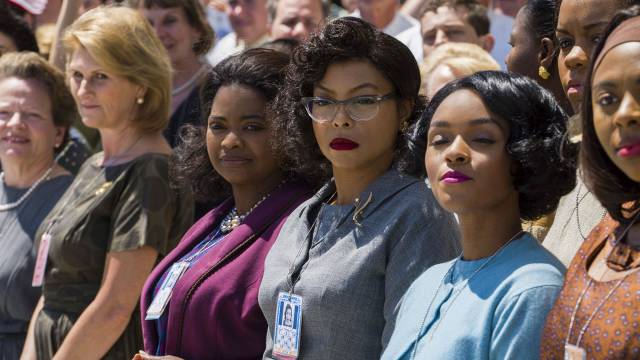Mediocre Inspiration, by Bob Connally
19 Jan
Several times throughout Hidden Figures, one of the film’s three protagonists- African-American women working at NASA in the early 1960s- will walk into a room, and dozens of white co-workers will turn to look, very surprised at who they see. Some of them look skeptical, some alarmed, some distrustful, and others still, are clearly upset. While this could have become a heavy-handed visual to repeat so many times, it quietly becomes an interesting thematic idea which ties into a claim one of the three women makes during the film. The idea of how important it is to be first. This was true of the space race between the United States and the Soviet Union and it was true for the women working for their opportunity to be a part of that race. What these women find is that the first one through the door isn’t always welcome there. The first is often greeted with hostility or incredulity. To be accepted, the first can’t merely be competent. The first has to be great.
In the early ‘60s, the American space program is lagging behind the Soviets and is desperately trying to play catch up. NASA’s personnel includes the efforts of “colored computers;” a large number of black female mathematicians who calculated shuttle trajectories by hand. These include Katherine Goble (Taraji P. Henson), should-be supervisor Dorothy Vaughan (Octavia Spencer), and Mary Jackson (Janelle Monae). Despite their brilliance and their inherent value to the space program, living and working in segregated Virginia means performing their calculations in a crowded basement office and in Mary’s case, not legally being able to attend the classes she needs to take to fulfill her ambition to become an engineer.
After their early scenes together, the three protagonists have their own separate storylines through the rest of the movie, with one clearly having the most narrative thrust. As Mary fights for the opportunity to take segregated college courses and Dorothy seeks the supervisory position she has unquestionably earned (and is already performing without recognition or title), Katherine is promoted to the Space Task Group, becoming the first African-American woman in the department. She will be working on the math that will not only send the first American into space but that will safely bring him home. It’s a job made all the more difficult by having so much information she needs to perform her job redacted by dismissive head engineer Paul Stafford (Jim Parsons) and by needing to spend a half hour running across campus every time she needs to use the bathroom due to segregation laws, taking a stack of work with her whenever she does.
Based upon the book of the same name by Margot Lee Shetterly, Hidden Figures has a screenplay by Allison Schroeder and Theodore Melfi, and is directed by Melfi (St. Vincent). It’s a movie that would have benefitted either from expanding into a mini-series or by making Katherine Goble its sole focus. Dorothy Vaughan and Mary Jackson have important stories worthy of being told but they are underserved here, feeling crammed into the 2 hour, 7 minute running time. A mini-series could have given Dorothy and Mary’s stories room to breathe and develop. Unfortunately, the movie takes a middle ground which left me simultaneously wanting more and wishing that the film had kept its focus on Katherine and her work on getting Alan Shepard (Dane Davenport), Gus Grissom, and John Glenn (Glen Powell) into space.
Hidden Figures is at its strongest when it shows us Katherine working on calculations and shuttle trajectories. Giving us a glimpse into the mind of an incredibly brilliant woman, whom Henson brings to life with her terrific performance. She brings us in to feel her joy at breakthroughs and her frustrations at setbacks. Ultimately though, the movie too often takes a by the numbers approach, going for certain emotional buttons in ways that feel all too familiar. The end result is still a competent and solid film. But these were incredible people who did amazing things and did them in a world that was largely against them. People like that deserve an extraordinary movie that makes us feel the weight of their struggles and triumphs in a more palpable way. Melfi is more interested in making this a feel good story that deals with the racial problems the characters face primarily on a surface level. He never challenges the audience, opting instead to let the viewer simply feel superior to the characters portrayed by Parsons and Kirsten Dunst.
I stated in my review of Hacksaw Ridge that, “[F]ilms about real life historical heroes are often given a pass by a certain percentage of their audience. …[T]he mere fact that the story of a laudable figure is being told is enough for some.” It feels as though Melfi was counting on that. This certainly didn’t make him so lazy that he mailed Hidden Figures in, but he also didn’t make it into the film it really could have been. Katherine Goble Johnson, Dorothy Vaughan, Mary Jackson, and the many pioneers with whom they worked are worthy of a movie that strives to be more than ordinary. They had to be great. This movie could have been too.




No comments yet